The classic British dessert has been loved for generations. It shows the rich food history of the UK.
This timeless favorite brings warmth and nostalgia. Its simplicity makes it a favorite for many.
Looking into the classic recipe uncovers its lasting appeal. With a few simple ingredients and patience, you can make a creamy dessert. It’s sure to become a family favorite.
Key Takeaways
- Discover the rich heritage behind the classic UK-style dessert.
- Learn the simple ingredients needed for the traditional recipe.
- Understand the cultural significance of this beloved treat.
- Explore tips for achieving the perfect creamy texture.
- Find out how to make this dessert a part of your family’s traditions.
The Rich Heritage of UK Rice Pudding
Rice pudding has a long history in the UK, dating back to ancient times. It has become a beloved British dessert. This comforting dish has been enjoyed by generations, bringing warmth and joy to all.
Origins and Cultural Significance
The history of rice pudding in the UK is linked to cultural and culinary exchanges. It became popular when rice was imported from colonies. Today, it symbolizes warmth, comfort, and nostalgia, reminding us of our childhood.
How Rice Pudding Became a British Staple
Several factors made rice pudding a favorite in the UK:
- The availability of rice due to trade
- The simplicity of the recipe, using basic ingredients like milk, sugar, and eggs
- Its adaptability to various flavors and textures
The traditional English rice pudding is known for its creamy texture and a skin that forms on top when baked. This old-fashioned rice pudding is a cherished dessert, showing the enduring appeal of traditional recipes.
Traditional Rice Pudding UK Recipe: What Makes It Special
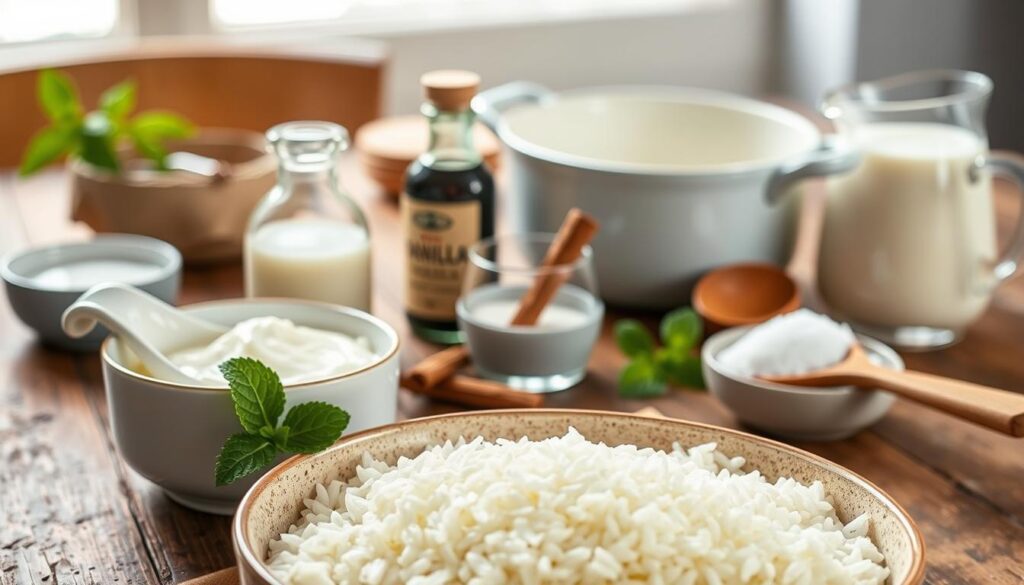
Rice pudding is a beloved part of British cuisine. It’s special because of its traditional rice pudding ingredients. This dessert has been loved for generations, thanks to its creamy texture and the memories it brings back.
Key Characteristics of Authentic British Rice Pudding
An authentic British rice pudding is known for its creamy rice pudding recipe. It uses the right rice and dairy. The pudding is made with short-grain rice, which makes it creamy.
The Beloved Skin on Top
The skin on top of a traditionally baked rice pudding is loved by many. This caramelized layer adds texture and flavor. It’s formed by the Maillard reaction when the pudding is baked.
Regional Variations Across the United Kingdom
While the core ingredients of rice pudding stay the same across the UK, there are regional rice pudding variations. Some add salt, while others use cinnamon or nutmeg.
These variations show how the traditional recipe can be enjoyed in different ways across the country.
Related: 5 Sweet Steps to Make Cotton Candy at Home
Essential Ingredients for Perfect Rice Pudding
The key to a tasty homemade rice pudding is in its ingredients. To craft the best rice pudding recipe, picking the right parts is essential.
Types of Rice Best Suited for Pudding
It’s important to choose the right rice. Pudding rice, or short-grain rice, is perfect. It has lots of starch, making the pudding creamy.
Pudding Rice vs. Arborio and Other Alternatives
Arborio rice can work, but it’s not the top pick for pudding. Pudding rice gives a better texture. Jasmine or basmati rice won’t do as well because they stay firmer.
| Rice Type | Characteristics | Suitability for Pudding |
|---|---|---|
| Pudding Rice | Short-grain, high starch | Excellent |
| Arborio Rice | Short-grain, high starch | Good |
| Jasmine/Basmati Rice | Long-grain, lower starch | Poor |
Dairy Options and Their Effects on Flavor
The type of dairy you use changes the pudding’s taste and creaminess. Whole milk is classic, but you can try almond milk or cream for different flavors.
Sweeteners and Traditional Flavorings
Sugar is the usual sweetener, but honey or maple syrup can add special tastes. Vanilla and a bit of salt are traditional additions to boost sweetness.
Kitchen Equipment You’ll Need

The right cooking vessels are key to perfect rice pudding. Whether using old methods or new gadgets, the right tools matter a lot.
Traditional Baking Dishes
For a classic rice pudding, a ceramic or glass baking dish is best. These materials spread heat well, making the pudding creamy. A deep, round dish is often used in British recipes.
Modern Cooking Vessels
Modern ways offer more choices. You can use a slow cooker for easy cooking, an Instant Pot for quick results, or a microwave-safe bowl for fast pudding. Each method can make great pudding with the right steps.
Optional Tools for Enhanced Results
Some tools can make your pudding better. A wooden spoon is great for stirring. A fine-mesh sieve helps rinse the rice well. For creamier pudding, try an immersion blender.
| Equipment | Use | Benefit |
|---|---|---|
| Ceramic Baking Dish | Oven-Baked Rice Pudding | Even heat distribution |
| Slow Cooker | Hands-Off Cooking | Convenience and creamy texture |
| Instant Pot | Quick Cooking | Fast preparation and rich flavor |
Preparing Your Ingredients: Pre-Cooking Steps
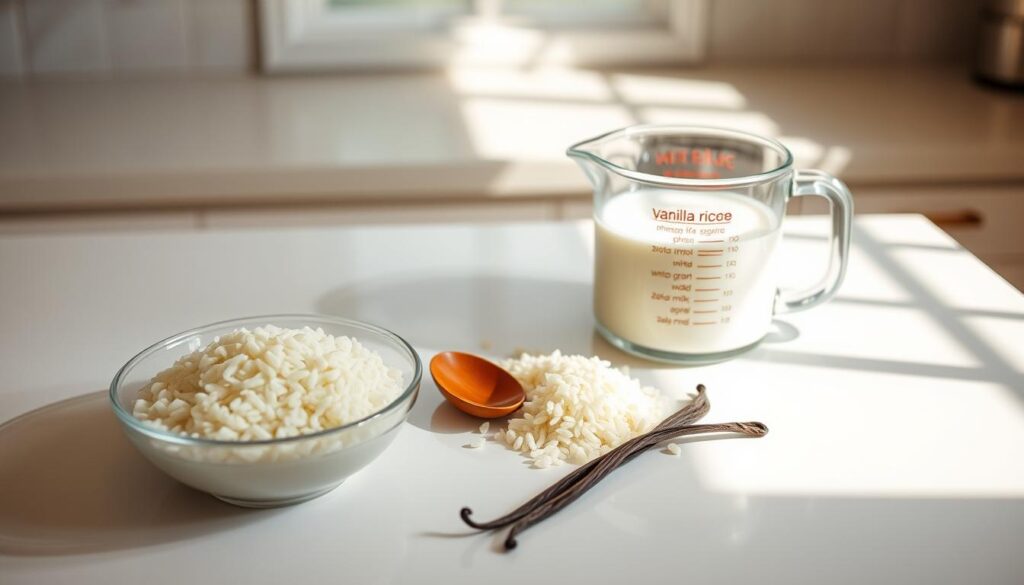
The secret to a great rice pudding is in how you prepare its ingredients. Doing it right makes sure your pudding cooks well and tastes amazing.
Measuring and Preparing Rice
First, measure the right type and amount of rice. For a classic UK rice pudding, use short-grain rice. It makes the pudding creamy. Rinse the rice in cold water to get rid of extra starch, then drain it well.
Preparing Dairy Components
Then, get your dairy ready. Whole milk is best for its rich taste and creamy feel. You can also mix in some cream for an even creamier pudding. Make sure your dairy is fresh and at room temperature before cooking.
Incorporating Flavorings
Traditional flavors for rice pudding include vanilla and a bit of salt. Add a vanilla pod to the warming milk for extra flavor. Or, use vanilla extract once it’s cooking. A pinch of salt makes the pudding sweeter and more flavorful.
Step-by-Step Cooking Instructions
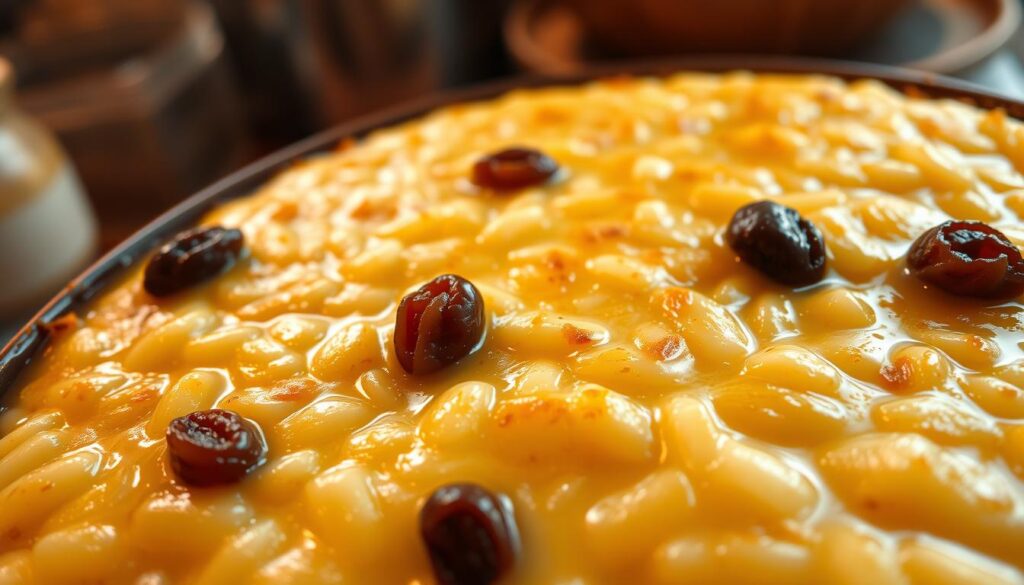
Making rice pudding is easy, whether you bake it in the oven or cook it on the stovetop. Both ways make a tasty dessert. Your choice depends on what you like better.
Classic Oven-Baked Method
The oven-baked method makes rice pudding creamy and gives it a golden skin. You need to follow certain steps for the best results.
Temperature and Timing Guidelines
First, heat your oven to 300°F (150°C). Place the rice pudding in a covered dish and bake for 45 minutes. Then, remove the cover and bake for another 15-20 minutes. This will make the top golden brown.
How to Achieve the Perfect Skin
To get a perfect skin, don’t stir the pudding for the last 20 minutes. This lets a crust form on top.
Stovetop Cooking Method
Cooking rice pudding on the stovetop gives you more control. It makes a creamy dessert. You need to know how to stir and when to stop cooking.
Stirring Techniques and Timing
Cook the rice and milk over medium heat, stirring all the time. Keep cooking until the rice is soft and the mix thickens. This usually takes 18-20 minutes. Stir often to stop the rice from sticking to the pan.
By following these steps, you can make a delicious rice pudding. Try both methods to see which one you like best.
Mastering the Perfect Consistency
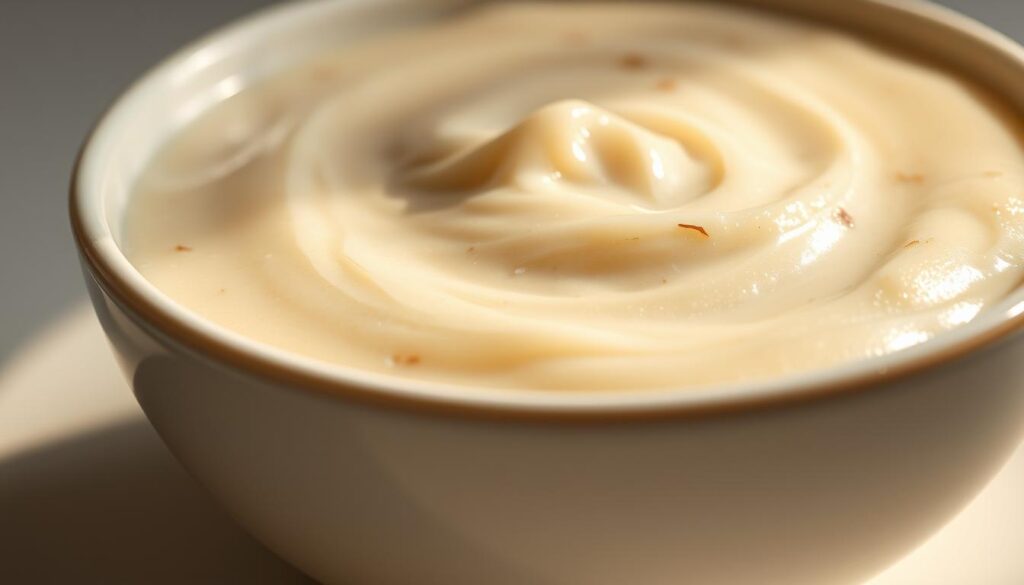
Creamy rice pudding is a classic comfort food. But getting the right consistency can be hard. You want it creamy and smooth, but it can easily become too runny or thick.
Achieving the Ideal Creaminess
To get the perfect creaminess, cook the rice slowly and gently. This helps the starches break down and mix well with the milk. Using the right type of rice is key; short-grain rice works best for its creamy texture.
Troubleshooting Common Texture Problems
Even with the best efforts, texture issues can happen. Here are some common problems and how to fix them:
- Too Runny: If it’s too runny, cook it a bit longer to reduce the liquid. You can also add more rice or cornstarch to thicken it.
- Too Thick: If it’s too thick, add a little more milk or cream. But be careful not to add too much, or it will become too runny again.
Too Runny: How to Fix
If your pudding is too runny, it might be because it’s undercooked or has too much milk. To fix it, simmer it gently on the stovetop or cook it longer in the oven.
Too Thick: Saving Your Pudding
If your pudding is too thick, it’s probably because it’s been overcooked. To fix it, stir in a bit more milk or cream to get the right consistency.
Common Mistakes to Avoid
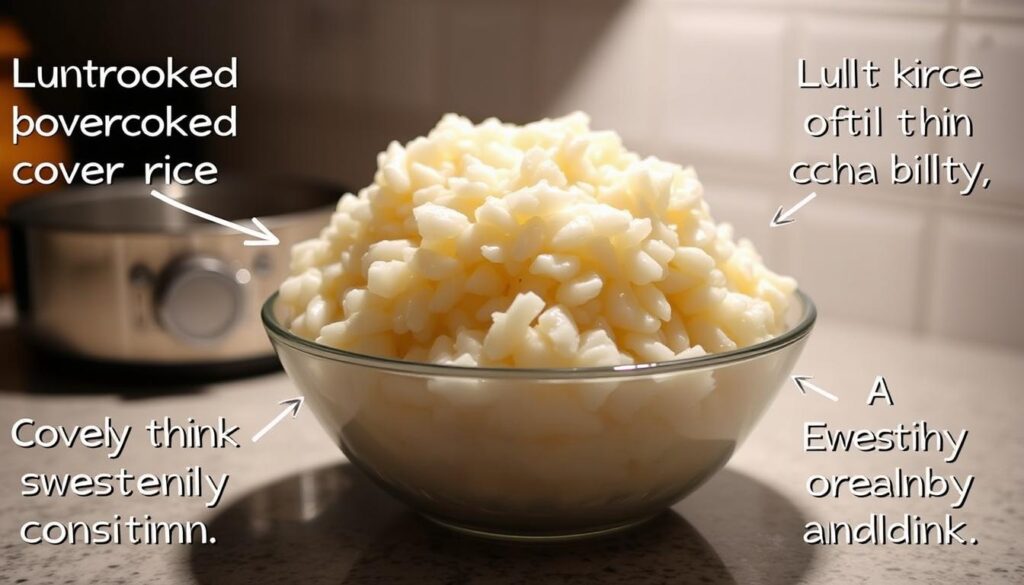
To make the perfect rice pudding, it’s important to avoid common mistakes. Knowing these errors can greatly improve your cooking.
Rice Selection Errors
Choosing the right rice is key. Short-grain rice is best for pudding because it soaks up liquid well and makes it creamy. Long-grain rice can make the pudding too dry.
Temperature Control Issues
Keeping the right temperature is critical. Cooking too hot can make the rice cook unevenly or the milk scald. Cooking too cold won’t cook the rice enough.
Stirring Mistakes
Not stirring enough can cause the rice to stick. Stirring too much can make the pudding too thin. It’s all about finding the right balance.
Avoiding these mistakes will help you make a delicious, creamy rice pudding. It’s sure to please your family and friends.
- Choose the right rice type
- Monitor your cooking temperature
- Stir appropriately
Flavor Variations and Add-ins
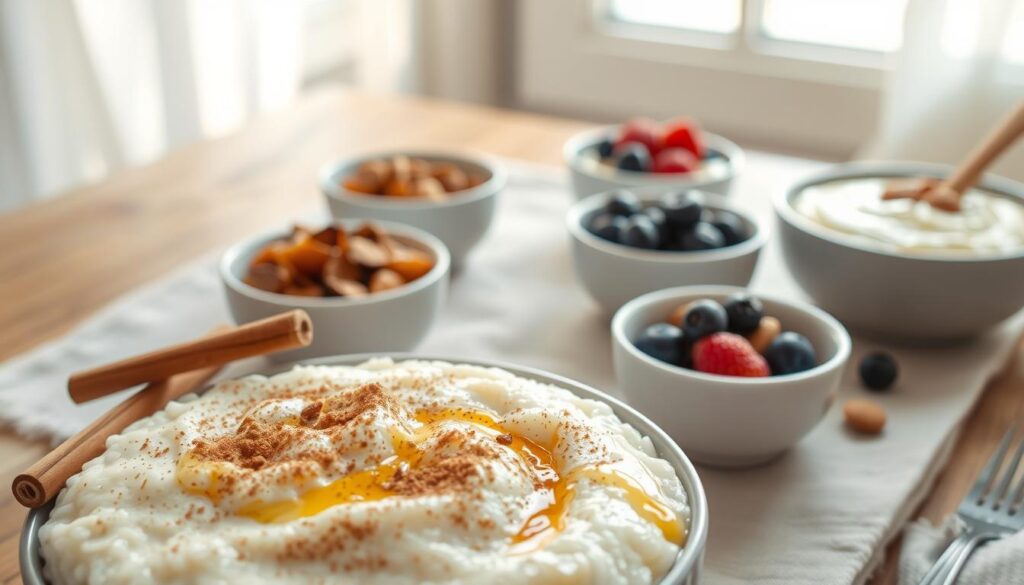
Rice pudding is a blank canvas for creativity. It can be paired with many flavors and ingredients. From traditional British tastes to modern twists, the possibilities are endless.
Classic British Flavor Enhancers
Traditional British flavors make rice pudding feel cozy. Nutmeg, cinnamon, and vanilla are perfect for this. They enhance the creamy texture beautifully.
Nutmeg, Cinnamon, and Vanilla
These spices and flavorings are key to traditional British desserts. Nutmeg adds a warm touch, while cinnamon brings comfort. Vanilla’s creamy sweetness holds everything together.
Fruit Additions and Jams
Fruit can turn rice pudding into a colorful dessert. Try adding stewed berries or your favorite jam. The fruit’s tartness balances the pudding’s richness.
Modern Twists on the Traditional Recipe
For those who love to experiment, there are many modern twists. Here are a few ideas:
- Cocoa powder or melted chocolate for a chocolatey version
- Dried fruits like cranberries or raisins for added texture
- A drizzle of caramel or honey for an extra layer of sweetness
| Flavor Variation | Description | Recommended Add-ins |
|---|---|---|
| Classic British | Nutmeg, cinnamon, and vanilla | Raisins, dried fruit |
| Fruity Twist | Stewed berries, jam | Fresh berries, citrus zest |
| Chocolate Indulgence | Cocoa powder, melted chocolate | Chocolate chips, marshmallows |
Making Rice Pudding in Modern Appliances
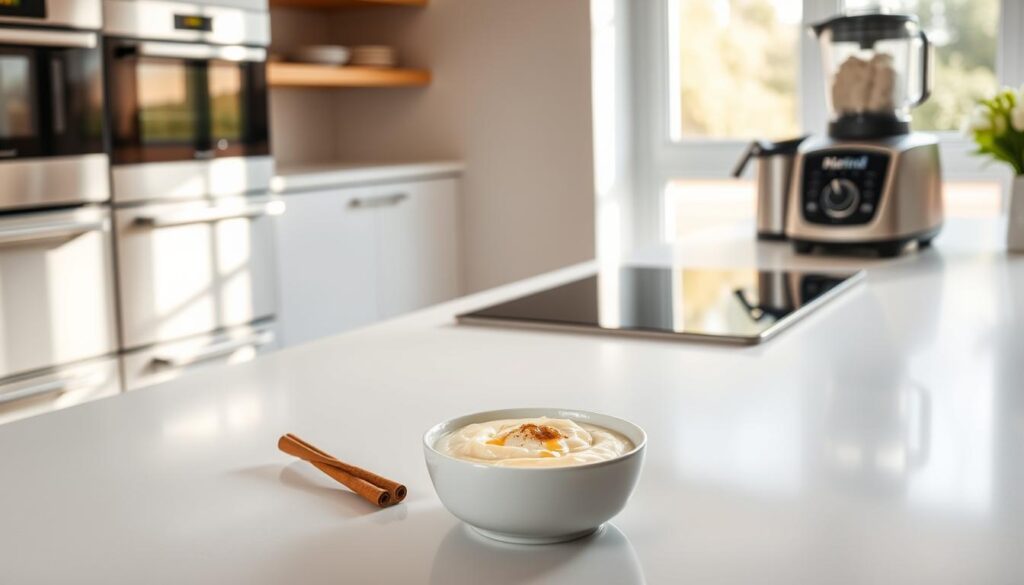
Modern kitchen appliances have changed how we make desserts like rice pudding. Now, you can use slow cookers, Instant Pots, and microwaves to make this comforting treat easily. This means you can enjoy it with less effort and watch over it less.
Slow Cooker Method
Using a slow cooker is a great way to make rice pudding. Just mix rice, milk, sugar, and your favorite flavors in it. Cook on low for 2-3 hours, stirring now and then, until it’s creamy and thick. This way, you get a creamy pudding without having to stir it all the time.
Instant Pot Adaptation
The Instant Pot makes rice pudding cooking fast. Just mix everything and cook on high pressure for 6-8 minutes. Then, let it rest for 10 minutes. This quick method gives you a creamy pudding with hardly any work.
Microwave Quick Version
For a fast rice pudding, try the microwave. Put rice, milk, and sugar in a safe bowl. Cook on high for 3-4 minutes, stirring every minute, until it’s creamy and the rice is cooked.
These modern appliances make making rice pudding easy and flexible. You can pick the method that fits your schedule and taste best.
Serving Suggestions and Storage
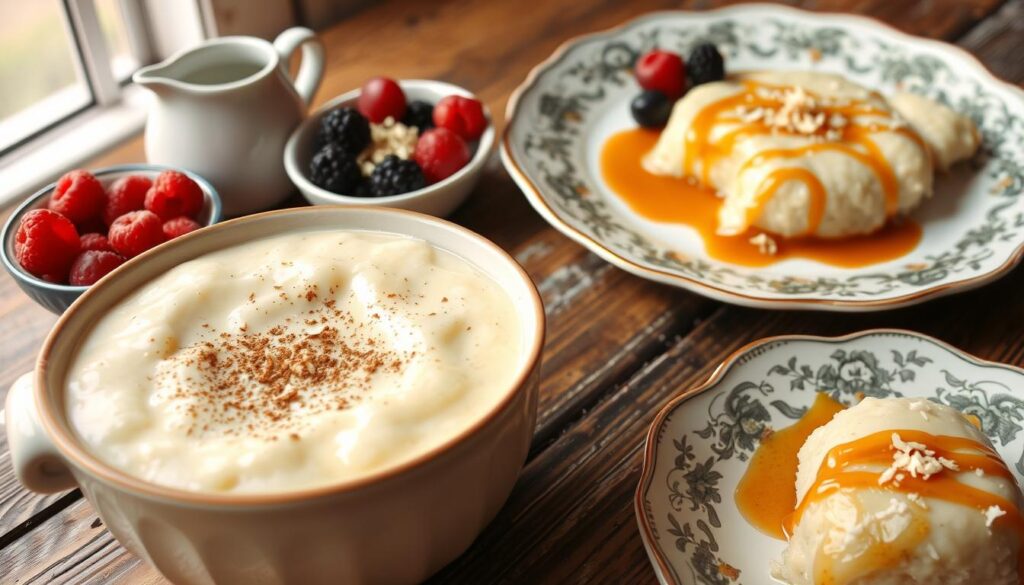
After making your UK-style rice pudding, it’s time to think about serving it. Rice pudding is versatile, allowing for many presentation styles. You can go from traditional to modern twists.
Traditional Serving Methods
Rice pudding is often served warm, topped with nutmeg. It’s a cozy dessert for chilly days. You can also chill it for warmer months.
Creative Presentation Ideas
For a modern touch, layer rice pudding with fruits or jams in a glass. You can also add toasted nuts or caramel for extra flavor and texture.
Proper Storage and Reheating Techniques
Leftover rice pudding can be stored in the fridge for up to 3 days. To reheat, warm it gently over low heat or in the microwave. Stir often to avoid burning.
| Storage Method | Duration | Reheating Tip |
|---|---|---|
| Refrigerator | Up to 3 days | Stir frequently when reheating |
| Freezer | Up to 2 months | Thaw overnight in the fridge before reheating |
Conclusion
Now you can make a tasty homemade rice pudding that everyone will love. Just follow the traditional UK recipe. You’ll get a creamy, comforting dessert that’s great for any time.
Looking for an easy recipe or want to try new flavors? The steps here will help you get started. So, try making this rice pudding and enjoy the cozy feelings it brings.
As you get better at making UK-style rice pudding, feel free to try new things. Add your own twist to make it special. Soon, you’ll be making this classic dessert like a pro, and it will be a favorite in your home.
FAQ
What is the best type of rice to use for traditional UK rice pudding?
For a true UK rice pudding, use pudding rice or short-grain rice. They keep their shape and make the pudding creamy. Long-grain or jasmine rice will make it too mushy.
Can I make rice pudding without a skin on top?
Yes, you can make rice pudding without the skin. Cover it with foil or use a different cooking method. But, many love the skin for its texture and taste.
How do I prevent my rice pudding from becoming too runny or too thick?
To get the right consistency, adjust the rice to liquid ratio. Watch the cooking time and temperature. If it’s too runny, cook it longer or add more rice. For a thicker pudding, add a bit more milk or cream.
Can I make rice pudding in advance and refrigerate or freeze it?
Yes, you can make it ahead and store it in the fridge for 3 days or freeze for 2 months. Reheat it gently, adding milk if needed to keep it creamy.
What are some classic British flavor enhancers I can add to my rice pudding?
Traditional flavors include nutmeg, cinnamon, and vanilla. You can also add honey, sugar, or jam for a sweet taste.
Can I use alternative milks, such as almond or soy milk, in my rice pudding?
Yes, you can try different milks. But, they might change the flavor and texture. Adjust the recipe based on the milk’s thickness and sweetness.
How do I reheat rice pudding without causing it to curdle or separate?
Reheat it on low heat, stirring gently. Add milk if it’s too thick. Avoid high heat or microwaving to prevent curdling.
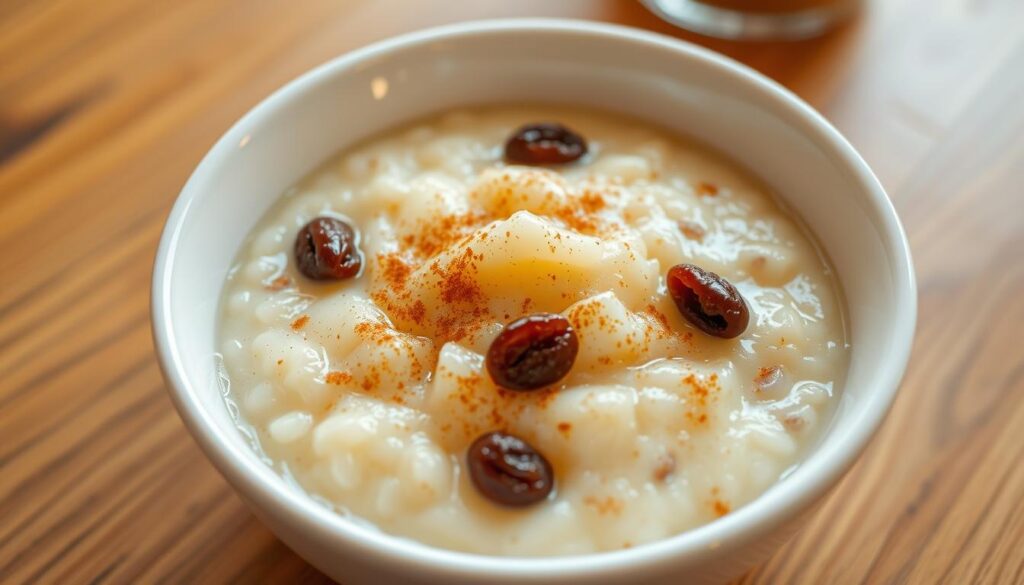


Pingback: 5 Sweet Steps to Make Cotton Candy at Home